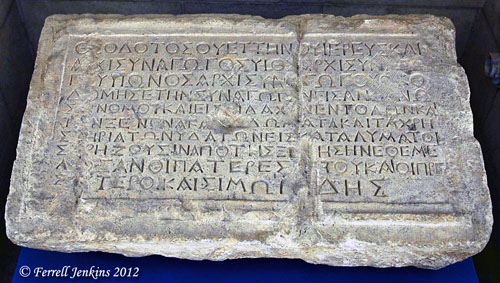'via Blog this'
Acts 6 — Photo Illustrations
Acts 6 records the selection of seven devout men to tend a need that has arisen among the new disciples of Christ. The function of these men seems similar to that of those later referred to as deacons (Philippians 1:1; 1 Timothy 3:8ff.).
One of these men, Stephen, had a leading role in the spread of the word and the resultant obedience to the faith by many. Even priests were becoming obedient to the faith. But there was opposition which eventually led to the stoning of Stephen.
Then some of those who belonged to the synagogue of the Freedmen (as it was called), and of the Cyrenians, and of the Alexandrians, and of those from Cilicia and Asia, rose up and disputed with Stephen. (Acts 6:9 ESV)
These Freedmen were liberated slaves (“Former Slaves” in the CEB). The termLibertines used in the KJV and the ASV probably leaves the wrong impression to a modern reader.
An inscription was discovered by French Archaeologist Raymond Weill in 1914 (some say 1913) in the area of the hill of Ophel or the City of David, south of the Temple Mount in Jerusalem.
The inscription is known as the Theodotus Inscription. Theodotus was the name of the priest and synagogue ruler whose name is the first word of the inscription. It is 25″ wide and 17″ high. This synagogue was for the use of Jews of the Diaspora when they visited Jerusalem. Saul of Tarus in Cilicia was probably comfortable among those who assembled there.
Herschel Shanks says this synagogue,
“is one of the most dramatic archaeological finds of the century. Like the Masada synagogue, it serves to confirm rather than to challenge our expectations regarding the existence of pre-destruction synagogues. For the Talmud tells us that before the Roman destruction of the Temple there were 394 synagogues in Jerusalem and gives us much the same picture of the synagogue as the one offered by the Jerusalem synagogue inscription. (Judaism in Stone: The Archaeology of Ancient Synagogues, 20)
This inscription was formerly displayed in the Rockefeller Museum, but is now exhibited in the Israel Museum. Click on the image for a larger one.
The translation of the Greek inscription reads as follows:
“Theodotus son of Vettenus, priest and synagogue leader, son of a synagogue leader, grandson of a synagogue leader, rebuilt this synagogue for the reading of the Law and the teaching of the commandments, and the hostelry, rooms and baths, for the lodging of those who have need from abroad. It was established by his forefathers, the elders and Simonides.” (Shanks, BAR, July/Aug 2003.)
The phrase “synagogue leader” which is used three times in the inscription is the Greek term archisunagogos. Luke uses the same term three times in his history of the early church (Acts 13:15; 18:8; 18:17). In each case he is writing about a synagogue leader of the Diaspora Jews.


No comments:
Post a Comment